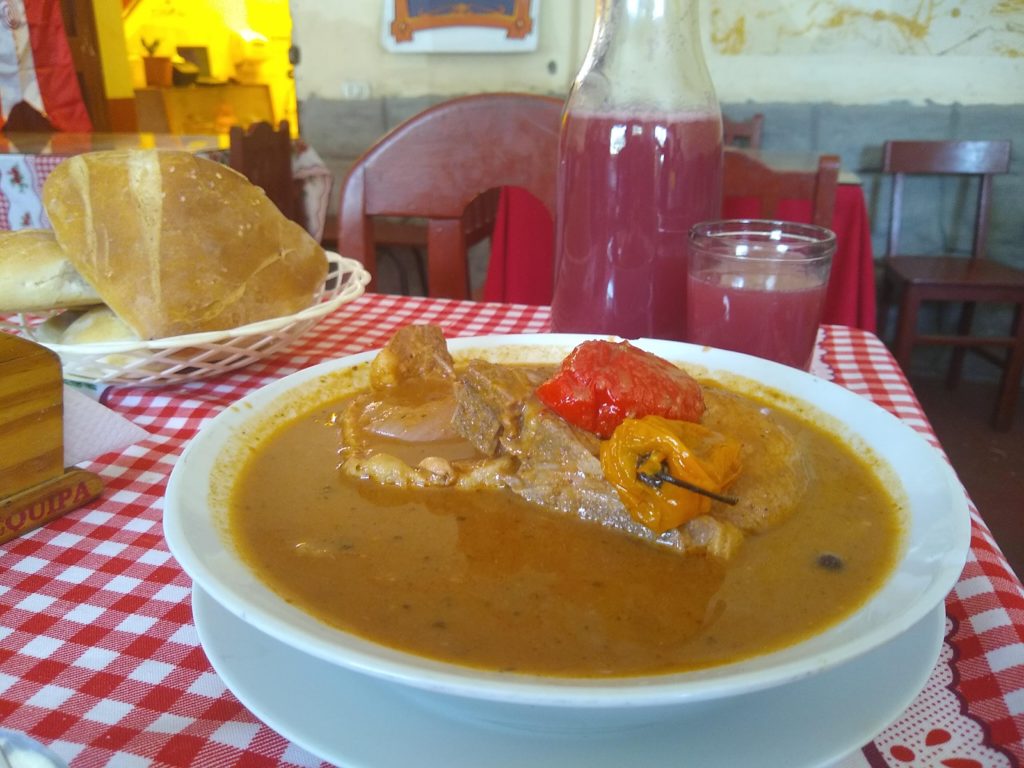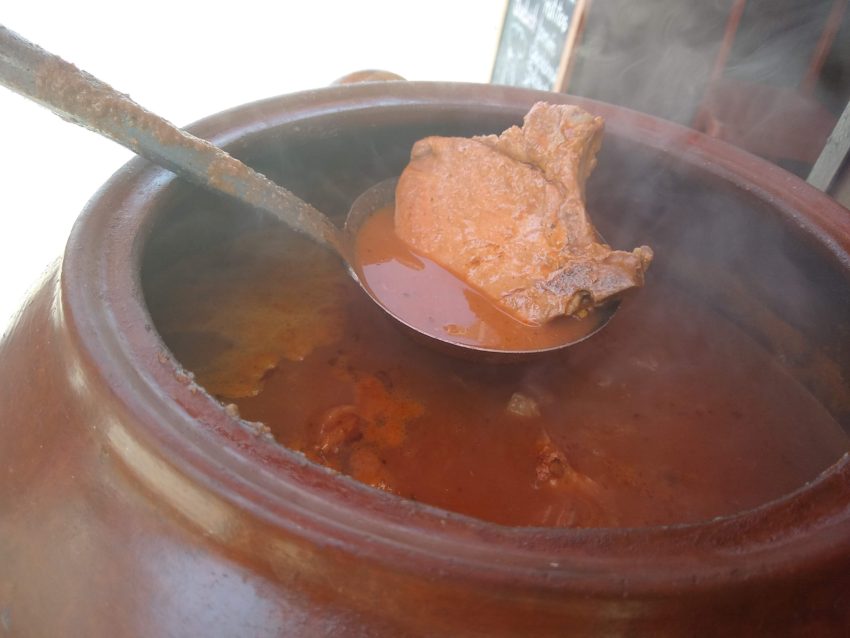Spain claims adobo as their gastronomical invention, but the technique of preserving meats using vinegar and spices is common to many cuisines. In Peru, the most famous pork adobo comes from the Cayma district in the southern city of Arequipa and uses chicha, a wild-fermented corn drink, instead of vinegar as the base for marinating and simmering the meat. A Spanish historian claims local indigenous women created the dish around 1525 to seduce its country’s soldiers, an effect the dish continues to have on anyone lucky enough to try it.
We arrived at the Plaza de Cayma about noon and could smell the adobo bubbling in claypots in front of the modest family restaurants that frame the square. Renee explained to the woman stirring the abodo in front on Elsita’s that we wanted to talk with the cook, if possible. We were immediately whisked to Vanessa, one of the three generations of family members working at Elsita’s.
Restaurants all over Arequipa offer adobo, particularly on Sunday mornings, as the dish is often enjoyed before or after mass. All the locals we quizzed either recommended Adobos Elsita’s in Cayma or confirmed that it made excellent pork adobo. And so, after sampling other adobos during the week, we made our pilgrimage to the adobo Mecca of Peru one Sunday morning.
Vanessa explained that the chicha they fermented for the marinade and cooking liquid included a secret selection of spices. They also used dried aji panca peppers and fresh rocoto peppers for added spice. Elsita’s uses pork chops, which they call lomo.

After hearing about the cooking process, it was time to taste the adobo. Our waiter brought two steaming bowls of the colorado-colored stew to the table. The broth was rich and mildly spicy, complementing the slightly sour chicha base. Large petal-shaped slices of cooked onion provided a touch of sweetness that balanced the flavors.
The perfect beverage to accompany adobo is chicha de jora, the same slightly soured corn beer used as the base for the marinade and cooking liquid. The lightly alcoholic chicha is wildly popular in Latin and South America, with street vendors selling fresh chicha either by the glass or in disposable plastic bottles. Given licensing requirements, we don’t see fresh chicha sold anywhere in the States. We ordered a liter of the purple chicha to wash down the adobo.
Combining what Vanessa revealed about her family recipe and what we could fill in from other versions, we offer the following recipes. Note that the volume of the chicha batch is meant to serve as both the cooking liquid and the drink to have at the meal.
To make the Chicha de Jora:
Ingredients:
- 2 pounds jora corn (which you can now buy online)
- 2 pounds piloncillo or other raw sugar
- 4 sticks cinnamon
- 1 small pineapple, chunked, INCLUDING THE SKIN
- 1 gallon water
Preparation:
- Soak the jora for half an hour.
- Heat the water to 160 degrees, and hold at that temperature for an hour. If you heat the liquid in a crock pot or Instant Pot, the “keep warm” setting works perfectly.
- Remove heat, add cinnamon sticks, cover.
- When the liquid has cooled to room temperature, add chunks of cut up pineapple. It’s the yeast and bacteria on the pineapple skin that starts the fermentation. Replace cover.
- After three days the chicha should be bubbling and is ready to strain for cooking and drinking. It will continue to ferment for a few more days till the natural yeast converts the remaining sugar into alcohol. When it stops bubbling, fermentation is complete and you need to either strain and drink or refrigerate it to keep it from spoiling.
To Make the Pork Adobo:
Ingredients:
- 4 lbs pork chops
- 6 cloves garlic, minced
- 2 white onions, quartered
- 2 tbsp salt and pepper
- 2 tsp ground cumin
- 2 tsp smoked paprika
- 3 cups chicha de jora
- 1 tbsp ground aji panca peppers or paste
- 2 whole rocoto peppers
Marinate the pork:
- Marinate the meat overnight with the aji panca, cumin, paprika, chicha, and garlic.
Cook the pork:
- Transfer pork to pot, add marinade, onions, and rocoto pepper, and simmer the marinade and meat for at least 1 1/2 hours.
- Serve the adobo with crusty bread.
- If someone wants more spice, serve them a cooked rocoto pepper.
